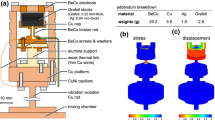Abstract
Measurements of the thermal conductivity are reported for an 80%3He-20%4He mixture above the critical point along several isotherms and near-critical isochores, using the same techniques and apparatus described for a study of3He. Using again the assumption that the observed conductivity λ can be decomposed into a sum of a regular and a singular contribution λreg and λsing, it is shown that along two near-critical isochores, λsing diverges. In particular, along the isochore showing the largest λ at the phase transition, the divergence is nearly the same as for3He and can be roughly characterized by a simple power law (T-Tc)−ψ with Ψ≈0.58. This observation is contrary to predictions that foresee λsing→0 asT c is approached. The relaxation times characterizing the attainment of steady state conditions after switching the heat flux on and off show a similar behaviour as a function of reduced temperature as do those for pure3He. This result might indicate a substantial coupling between concentration and entropy diffusion. In the Appendix, the correlation length for3He nearT c is calculated from heat conductivity, viscosity, and specific heat data.
Similar content being viewed by others
References
C. E. Pittman, L. H. Cohen, and H. Meyer,J. Low Temp. Phys. 46, 115 (1982).
R. P. Behringer and H. Meyer,J. Low Temp. Phys. 46, 853 (1982).
L. Mistura,Nuovo Cimento B 12, 35 (1972);J. Chem. Phys. 62, 4572 (1975).
L. D. Landau and E. M. Lifshitz,Fluid Mechanics, Chapter VI (Pergamon Press, 1959).
R. B. Griffiths and J. C. Wheeler,Phys. Rev. A 2, 1047 (1970).
P. C. Hohenberg and B. I. Halperin,Rev. Mod. Phys. 49, 435 (1977).
M. A. Anisimov, A. V. Voronel, and E. E. Gorodetskii,Zh. Eksp. Fiz. 60, 1117 (1971) [Sov. Phys.—JETP 33, 606 (1971)].
E. D. Siggia, B. I. Halperin, and P. C. Hohenberg,Phys. Rev. B 13, 2110 (1976).
I. G. Gerts and L. P. Philippov,Zh. Fiz. Khim. 30, 2324 (1956) [NBS report S-126098-65 (January 1965)].
T. Doiron, R. P. Behringer, and H. Meyer,J. Low Temp. Phys. 24, 345 (1976), and references therein.
B. A. Wallace and H. Meyer,Phys. Rev. A 5, 953 (1972).
Y. Miura, H. Meyer, and A. Ikushima,Phys. Letters A (to be published).
J. M. Goodwin, A. Hirai, T. Mizusaki, K. Tsuboi, and T. K. Waldschmidt,Physica 107B, 351 (1981); and private communication.
S. S. Leung and R. B. Griffiths,Phys. Rev. A 8, 2670 (1973).
R. P. Behringer, T. Doiron, and H. Meyer,J. Low Temp. Phys. 24, 315 (1976).
T. Doiron, C. E. Pittman, and H. Meyer,Phys. Rev. B 20, 3678 (1979).
A. Acton, private communication (1978).
D. B. Roe and H. Meyer,J. Low Temp. Phys. 30, 91 (1978).
K. Ohbayashi and A. Ikushima,J. Low Temp. Phys. 19, 449 (1975).
J. V. Sengers and J. M. J. Van Leeuwen, to be published, and references therein.
Author information
Authors and Affiliations
Additional information
Work supported by Grant DMR 8024056 of the National Science Foundation.
Rights and permissions
About this article
Cite this article
Cohen, L.H., Dingus, M.L. & Meyer, H. Transport properties of helium near the liquid-vapor critical point. II. Thermal conductivity of a3He-4He mixture. J Low Temp Phys 49, 545–558 (1982). https://doi.org/10.1007/BF00681900
Received:
Issue Date:
DOI: https://doi.org/10.1007/BF00681900




